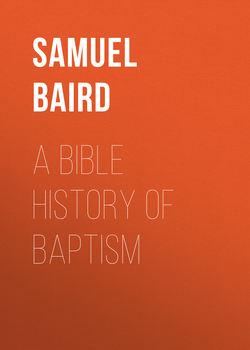Читать книгу A Bible History of Baptism - Baird Samuel John - Страница 21
Book I.
OLD TESTAMENT HISTORY
Part III.
ADMINISTERED BAPTISMS=SPRINKLINGS
Section XVIII. —The Baptism of Infants
ОглавлениеWe have seen that in the Abrahamic covenant, – the betrothal of the church, – the infant sons were expressly included on equal terms with their fathers; and that in the Sinai espousal the infants of both sexes were joined with their parents in the bonds of the covenant, and in the reception of its baptismal seal. We have seen the young daughters of Midian purified and admitted to the covenant and church of Israel by the same sacrament. By these unquestionable facts, the principle of infant membership in the church, and the mode of its certification by baptism, are both alike clearly established. The Scriptures contain conclusive evidence that the children of after generations of Israel were received to the covenant and the church in like manner, by baptism with the water of separation.
1. The law of God was explicit that “one ordinance shall be both for you of the congregation and also for the stranger that sojourneth with you, an ordinance forever in your generations; as ye are so shall the stranger be before the Lord. One law and one manner shall be for you and for the stranger that sojourneth with you.” – Num. xv, 14-16. From this law, it results as a necessary conclusion, that inasmuch as the Midianite children were baptized, the same must have been the rule for the infants of Israel.
2. Circumcision was the seal of the Abrahamic covenant, but not of that of Sinai. So long as the church was confined to the family of Israel after the flesh, this rite, as being the proof and seal of membership in that family was essential as a condition precedent to the enjoyment of the privileges of the church; but did not, of itself, seal or convey a right to them. Otherwise, every circumcised person would have been entitled to those privileges; whereas they were reserved exclusively for the clean.
3. While such was the case, it was a fundamental article of the faith from the beginning, that men are all natively unclean. Job, Eliphaz, and Bildad, each severally states it as an unquestionable proposition that man born of woman must be so. (Job xiv, 4; xv, 14; xxv, 4.) David cries: “Behold I was shapen in iniquity and in sin did my mother conceive me… Purge me with hyssop and I shall be clean; wash me and I shall be whiter than snow.” – Psalm li, 5-7. He not only recognizes the radical nature of his moral corruption as born in him, but indicates the remedy under the very figure of sprinkling with the water of nidda, to which the hyssop refers. The Lord Jesus, speaking at a time when the Old Testament ordinances and system were still in full force, testifies, “That which is born of the flesh is flesh, and that which is born of the Spirit is spirit. Marvel not that I said unto thee, Ye must be born again.” – John iii, 6, 7.
4. To signalize this native corruption of man and the remedy, the ordinances concerning the defilement of nidda and its cleansing were appointed. In them the new born infant was regarded as the product of overflowing corruption, and as a fountain of defilement to the mother, who thus became unclean, until purified with the water of separation.
5. The child was identified with the mother in this uncleanness (1) as being its cause in her; (2) as being subject to her touch, which was defiling to the clean; and (3) as being bone of her bone and flesh of her flesh, born of her body.
6. In accordance with the doctrine of man’s native defilement, above illustrated, it was characteristic of the law that it recognized none as clean, unless purged by water of sprinkling. The infants at Sinai were so purified and admitted to the covenant, as well as their parents. So it was with the daughters of Midian; and no other principle was known to the law, – no other practice tolerated by it. “The man” (the person) “that shall be unclean, and shall not purify himself, that soul shall be cut off from among the congregation, because he hath defiled the sanctuary of the Lord: the water of separation hath not been sprinkled upon him; he is unclean.” – Num. xix, 20.
7. It is a very remarkable fact, that while we have in the Scriptures but one single example specifically mentioned of the purifying of an infant from this ritual defilement of birth, that example occurs in the person of Him respecting whom the angel said to Mary, “That holy thing which shall be born of thee shall be called the Son of God.” – Luke i, 35. In the same gospel in which is this record, we read, respecting Mary, in the common version, that “when the days of her purification, according to the law of Moses, were accomplished, they brought Jesus to Jerusalem to present him to the Lord.” – Ib. ii, 22. But it is agreed by critical editors that this is a corrupted reading, which is wholly without authority from any respectable manuscript. Instead of “the days (autēs) of her purification,” it should read (autōn), “the days of their purification;” that is, of both mother and child. Beside all the other authorities, the three oldest manuscripts, Sinaiticus, Vaticanus, and Alexandrinus, unite in this reading. How the mothers were purified, we have seen; and, from these facts, we know the children to have shared with them in the baptism.
